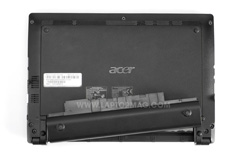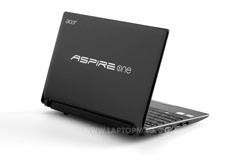Laptop Mag Verdict
One of the first netbooks with Intel's mobile dual-core Atom processor offers slightly improved performance but not the best user experience.
Pros
- +
Smaller and lighter than other netbooks
- +
Strong battery Life
- +
Above-average performance
- +
Runs cool
Cons
- -
Jumpy cursor
- -
Keyboard a bit cramped
- -
Washed-out webcam
- -
Annoying trialware
Why you can trust Laptop Mag
The Acer Aspire One D255 (price not yet announced) is Acer's first dual-core netbook, and one of the first 10-inchers anywhere to use Intel's new Atom N550 processor. The netbook's benchmark performance is moderately better than single-core competitors. We also like how portable this design is, even when compared to other lightweight netbooks. However, is the D255 fast enough to overcome some of its flaws?
Design
At 2.4 pounds and 10.1 x 7.3 x .95 inches, the D255 is smaller and lighter than competitors like the Eee PC 1215N (11.6 x 8 x 1.4 inches, 3.4 pounds), the Samsung N150 Plus (10.4 x 7.4 x 1.4 inches, 2.8 pounds), and the Toshiba NB305 (10.5 x 7.6 x 1.2 inches, 2.8 pounds). When carrying it around in our bag, we hardly felt its weight.
If you've seen other Aspire One netbooks, the Aspire One D255 will look very familiar too you because it shares their slim but somewhat generic design. Its glossy black lid is emblazoned with a drab Aspire One logo and picks up finger prints, but it's so dark you will hardly notice them. On the inside, a glossy bezel surrounds the extremely glossy screen, making it even more reflective. There's also a gap between the lid and the base of the chassis that's large enough to fit a pen through. You'll also find a matte gray deck and an island-style keyboard.
Keyboard and Touchpad
The island-style keyboard on the Aspire One D255 has the same "fine tip" design as other Acer netbooks and notebooks. Though the keys are large and extend end-to-end across the chassis, we found the overall typing experience cramped because of the narrow chassis and short palm rest that had our wrists hanging over the front lip. In addition, we noticed a little flex when we pressed down on the G and H keys. However, despite these issues, we were able to achieve our typical 80 words per minute score on the ten thumbs typing test, with a slightly higher than usual 2 percent error rate.
The 3 x 1.5-inch touchpad suffers from very serious inaccuracy problems. As we navigated around the desktop, occasionally the pointer would suddenly jump a few pixels and other times it seemed to slow to a crawl. This inaccuracy was more pronounced when tasks such as web page loading were occurring in the background. The pad supports multitouch gestures such as pinch-to-zoom but isn't smooth or consistent. Though we prefer two discrete mouse buttons, the D255's single-button bar offered good tactile feedback without being too stiff.
Sign up to receive The Snapshot, a free special dispatch from Laptop Mag, in your inbox.
Click to enlarge
Heat
The Aspire One D255 stayed relatively cool throughout our testing. Even after streaming a video at full screen for 15 minutes, we measured the keyboard at just 84 degrees, the touchpad at 85 degrees, and the bottom at a chilly 89 degrees Fahrenheit. We consider temperatures near 95 degrees Fahrenheit acceptable and those under 95 extremely pleasant. However, all that heat has to go somewhere. The air vent belched out 107-degree air, but not in the user's direction.
Ports and Webcam
The Aspire One D255 has a standard array of netbook ports. On the right side are a memory card reader, audio in/out jacks, a USB port, a Kensington lock slot, and an Ethernet port. On the left side are a VGA out and two more USB ports, for a total of three.
The 1.3-megapixel webcam produced blurry images that were completely washed out under fluorescent light. During a Skype call from our cubicle, our face was completely covered by shadow. When we moved next to a window, the image quality improved but was still a bit grainy.
Display and Sound
The Aspire One D255's 10.1-inch, 1024 x 600-pixel screen provided strong viewing angles, despite its glossy surface. Even at 45 degrees to the left or right, images got a little darker but did not wash out. Intel says that the Atom N550 improves high-def video playback, but when we downloaded a 720p QuickTime trailer of Saw 3D, playback was noticeably jerky. Streaming full-screen 720p Flash videos from Fox.com and another from YouTube, however, was smooth.
Audio quality from the bottom-mounted speakers was loud enough to fill a room, though somewhat tinny when we streamed "Party Train" by the Gap Band from Napster. Unfortunately, when we moved the pointer around during audio playback, we occasionally noticed some distortion as the audio itself seemed to slow down at times.
Performance
Click to enlargeThe dual-core 1.5-GHz Atom N550 CPU in the Aspire One D255 allowed it to achieve modestly higher scores than its single-core competitors. On PCMark05, a benchmark that measures overall performance, the system scored 1,696, about 15 percent higher than the category average of 1,424 and noticeably higher than the single-core Toshiba NB305 (1383) and Samsung N150 Plus (1300). However, the dual-core ASUS Eee PC 1015PEM managed a higher score of 1,729.
The D255's 250GB, 5,400 rpm hard drive booted Windows 7 Starter in a relatively brisk 55 seconds, 8 seconds faster than the category average. It took 3 minutes and 35 seconds to complete the file transfer test, in which we copy 4.97GB of mixed media files. That's a rate of 23.7 MBps, well above the 18.6 MBps category average and noticeably faster than the 20.6 MBps turned in by the Toshiba NB305 and the 21.6 MBps offered by Samsung N150 Plus. However, the dual-core ASUS Eee PC 1215N got a much-stronger 27.1 MBps rate.
When it came to transcoding video, the D255 really shined: It took the netbook only 4 minutes and 10 seconds to transcode a 114MB MP4 file to AVI using Oxelon Media Encoder. That time is about 1.5 times as fast as the category average of 6 minutes and 7 seconds, but not as speedy as the dual-core ASUS 1215N (3:17). However, that 12-inch netbook costs $150 more.
Graphics
The Aspire One D255's dual-core Atom CPU doesn't provide any real benefits when it comes to graphics performance. The integrated Intel GMA 3150 graphics provided the usual unimpressive performance. As stated previously, streaming 720p video from sites like Fox.com and YouTube was smooth, but a downloaded QuickTime trailer of Saw 3D caused the notebook to choke. Google Earth ran competently but was slow to draw when we circled the earth.
On 3DMark06, an overall graphics benchmark, the D255 scored only 151, less than the netbook category average of 293 but about on par with the Samsung N150 Plus (156) and the Toshiba NB 305 (151). The Ion-powered ASUS 1215N scored a whopping 2,692.
We don't normally do gaming tests on netbooks, but because of its dual-core processor, we tried World of Warcraft on the D255, with very mediocre results. At 800 x 600 resolution with all special effects turned down, we managed to get a barely playable 28 frames per second. However, with effects turned up, that rate dropped to only 16 fps. And, at the native resolution of 1024 x 600, the D255 notched a slideshow-like 6 fps.
Battery Life and Wi-Fi
Click to enlargeThe D255's dual core Atom N550 CPU had no negative effect on its battery life. The netbook lasted 8 hours and 14 minutes on the LAPTOP Battery Test, which involves continuous surfing over Wi-Fi. That's well ahead of the 6 hour and 35 minute netbook category average and well ahead of the 7:12 runtime provided by the Samsung N150 Plus. However, the ASUS Eee PC 1015PEM lasted 8 hours and 7 minutes and the Toshiba NB305 lasted 8 hours and 37 minutes.
The 802.11n Atheros AR8152 wireless card delivered subpar transfer rates of 18 and 15.5 Mbps at distances of 15 and 50 feet from the router, respectively. This compares poorly to the ASUS Eee PC 1215N (39.4/23.7 Mbps), Samsung N150 Plus (24.4/19.8 Mbps), and Toshiba NB305 (38.4/23.7 Mbps).
Software and Warranty
Click to enlarge The Acer Aspire One D255 comes preloaded with an extraordinary amount of trialware. It has both McAfee Internet Security and Norton Online Backup running by default. Until you register or uninstall both of these programs, they are extremely annoying as they periodically pop up alerts notifying you to purchase full versions.
Trial versions of EgisTec's Shredder (for shredding files) and MyWinLocker encryption software come preloaded, as do a dozen different trial versions of casual games. A lite version of eSobi, a news reader, also comes preinstalled.
When you get past the trialware, there's a minimal amount of Acer software on the D255, including Acer Video Conference (for controlling the webcam), Acer Crystal Eye webcam (for shooting photos and videos), and Acer eRecovery Management for backup and restore.
Acer bundles the Aspire One D255 with a one-year limited warranty. Tech support hours are from 8 a.m. to 10 p.m. EST (Mon-Fri), 8 a.m. to 6 p.m. (Sat), and 9 a.m. to 5 p.m. (Sun). See how Acer fared in our Tech Support Showdown.
Android Dual Boot (Not in U.S. Version)
In certain countries but not the United States, the Acer Aspire One D255 comes with Google Android 1.6 operating system available to dual boot with Windows 7 Starter. Though it won't be available to American consumers, our review unit had this enabled. Android 1.6 booted quickly but was largely disappointing. It has no marketplace support for downloading apps and no Google applications (maps, Gmail, etc.), but worse still, the hardware is not optimized for Google's touch-centric OS, because there are no home settings or Back keys (you have to right-click and then use the mouse), and the screen isn't touch-enabled.
Verdict
At first glance, the Aspire One D255 has a lot going for it. The $329 netbook has a low price, long battery life and is more portable than most netbooks in its class. And while the dual-core Atom N550 processor doesn't blow us away, we appreciate the modest performance gains. However, these small gains are offset by a very jumpy cursor and pestering trialware. Although some competitors don't last as long on a charge, we prefer the Samsung N150 Plus ($349) for its matte display and more responsive keyboard, and the Toshiba NB255 ($289), which has a better touchpad. If want a top-of-the-line keyboard and touchpad, check out the Toshiba NB305 ($399). If you want top-of-the-line graphics performance, consider the ASUS 1215N ($499).
Acer Aspire One D255 Specs
| Brand | Acer |
| CPU | 1.5-GHz Intel Atom N550 |
| Card Slots | SD memory reader |
| Company Website | http://www.acer.com |
| Display Size | 10.1 |
| Graphics Card | Intel GMA 3150 |
| Hard Drive Size | 250GB |
| Hard Drive Speed | 5,400rpm |
| Hard Drive Type | SATA Hard Drive |
| Native Resolution | 1024x600 |
| Operating System | MS Windows 7 Starter Edition |
| Ports (excluding USB) | Microphone, Kensington Lock, Headphone, Ethernet, VGA |
| RAM | 1GB |
| RAM Upgradable to | 2GB |
| Size | 10.17 x 7.28 x .95 inches |
| Touchpad Size | 3 x 1.5-inches |
| USB Ports | 3 |
| Video Memory | Shared |
| Warranty/Support | One year standard |
| Weight | 2.4 pounds |
| Wi-Fi | 802.11b/g/n |





